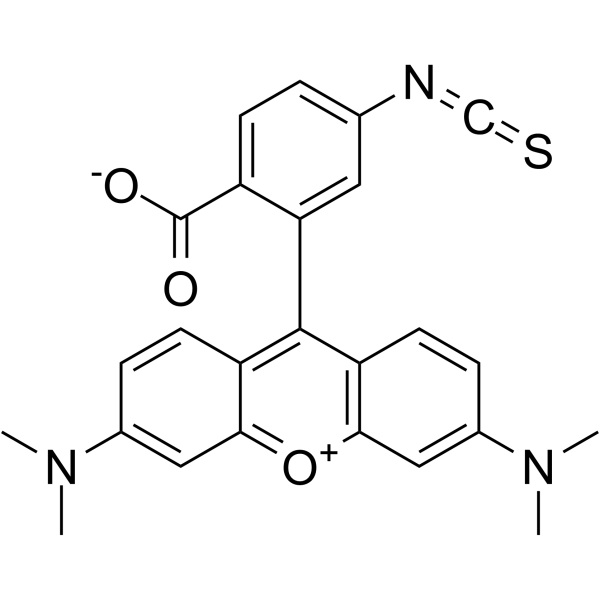Tetramethylrhodamine-6-isothiocyanate
Modify Date: 2025-08-25 07:40:59

Tetramethylrhodamine-6-isothiocyanate structure
|
Common Name | Tetramethylrhodamine-6-isothiocyanate | ||
|---|---|---|---|---|
| CAS Number | 80724-20-5 | Molecular Weight | 443.51800 | |
| Density | N/A | Boiling Point | N/A | |
| Molecular Formula | C25H21N3O3S | Melting Point | N/A | |
| MSDS | Chinese USA | Flash Point | N/A | |
Use of Tetramethylrhodamine-6-isothiocyanateTetramethylrhodamine-6-isothiocyanate is a potent fluorescent tracer. Tetramethylrhodamine-6-isothiocyanate can be used as an probe for haptenated proteins/peptides for the research of contact allergy. Tetramethylrhodamine-6-isothiocyanate can be used as a tracer for the confocal imaging in living cells[1][2]. |
| Name | 2-[3-(dimethylamino)-6-dimethylazaniumylidenexanthen-9-yl]-4-isothiocyanatobenzoate |
|---|---|
| Synonym | More Synonyms |
| Description | Tetramethylrhodamine-6-isothiocyanate is a potent fluorescent tracer. Tetramethylrhodamine-6-isothiocyanate can be used as an probe for haptenated proteins/peptides for the research of contact allergy. Tetramethylrhodamine-6-isothiocyanate can be used as a tracer for the confocal imaging in living cells[1][2]. |
|---|---|
| Related Catalog | |
| In Vitro | Tetramethylrhodamine-6-isothiocyanate is relatively photostable and robust toward pH changes[1]. Tetramethylrhodamine-6-isothiocyanate as an extreme sensitizer induces a massive cell proliferation and gave an EC3 value of 0.92 mM (0.040%) in the murine LLNA (local lymph node assay)[1]. Tetramethylrhodamine-6-isothiocyanate (1.0 mg; 2h) can used as fluorescence probe for confocal imaging in Fe3O4@PDA incubated living cells[2]. |
| References |
| Molecular Formula | C25H21N3O3S |
|---|---|
| Molecular Weight | 443.51800 |
| Exact Mass | 443.13000 |
| PSA | 104.20000 |
| LogP | 4.76390 |
| Storage condition | 2~8°C |
| Hazard Codes | Xn: Harmful; |
|---|
| 6-TRITC |
| T3163_SIAL |
| BIT3022 |
| 5(6)-Tetramethylrhodamine isothiocyanate |
| Tetramethylrhodamine-6-isothiocyanate |
| Tetramethylrhodamine isothiocyanate |